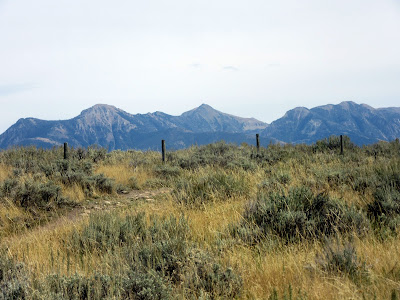Sunday September 6,
2015 day 40 Gallatin National Forest, Baker’s Hole
Campground, 3rd day
The days are getting colder.
Only 34o this morning.
We used the electric heating element in the A.C. to keep us warm during
the night, in addition to the two wool blankets. First time we’ve had heat on at night and
first time we’ve used the electric heat.
It was too cold to sit out, even with a fire. Stayed inside the cozy trailer.
Went into West Yellowstone for some grocery items. There is a quilt shop there that Marsha
wanted to poke around in. They had a lot
of western and outdoor themed fabric.
But, being Sunday, they weren’t open until noon. It was only 10:00. I went to Bud Lilley’s fly shop to buy 7-day
Yellowstone Park fishing license for $25.
Then the usual gas and ice.
But you have a Yeti cooler.
Why do you put ice in it so often?
I thought they were super insulated.
I keep the Yeti in the back of the truck. It mostly holds beer, but we also use it as
the overflow for our refrigerator for things like milk, that are kind of big
for our RV size refrigerator. For the
past 5 weeks we’ve stayed in campgrounds requiring bear practices, which means
nothing can be left out unattended, like coolers, grills, and at Yellowstone campgrounds, even
water jugs. So the Yeti is always in the
back of the truck. When we had temps in
the 70’s, the back of the truck gets hot, just like the cab when it sits in the
sun. That’s what’s using up the ice at
the rate of about 1 bag per day. Adding
new warm beer to it also sucks up ice.
Lately we’ve been using 1 bag every other day because of the cooler
weather. I’ve asked other Yeti owners
about their ice usage and they said the same thing. Keeping it in the back of the truck all the
time challenges it.
West Yellowstone has bear proof trash receptacles all over town. This year they are all painted with nature type themes so they look like pretty bear proof trash cans. I actually took some photos of them.
I went to the Madison River again at my normal spot. I parked on top of the bluff where I always
do.
 |
The bridge crosses the Madison River. I then go left (upstream) after crossing, about 1 mile. |
You've probably seen some of these pictures already, but I love the view from up there on the bluff that I always take pictures of the surrounding area.
 |
| The meadow I take 30 minutes to cross. |
 |
| Almost at the river. |
 |
| Looking upstream towards my favorite fishing hole. |
 |
| At the river at one of my favorite fishing holes. |
 |
| Looking east from my parking spot. |
 |
| Looking north from the bluff. |
 |
| Looking northeast from the bluff. |
After my 30 minute walk across the meadow I went upstream
another ¼ mile and spent the next 3 hours nymphing the fast water. I hooked three fish, one of which was about
18”. But I netted zero. The big one broke off just as I netted him and
away he went.
You hear me talk about nymphing a lot. When no insects are hatching and it’s too
cold for terrestrials like grass hoppers, beetles, and ants, you have to go
underwater. Nymphs are the larva of the
acquatic insects and they live under the rocks in the river. This is the food source for the trout when
nothing else is happening. So you use
flies that imitate the nymphs. They are
weighted and are drifted below a strike indicator. We hate to admit it, but the strike indicator is like a bobber. I'll take a picture of some nymphing flies in an upcoming post.
Got back to the campground at 17:00 and made barbequed
boneless chicken breasts. Super
good. Hung out inside. Too cold to sit out.





No comments:
Post a Comment